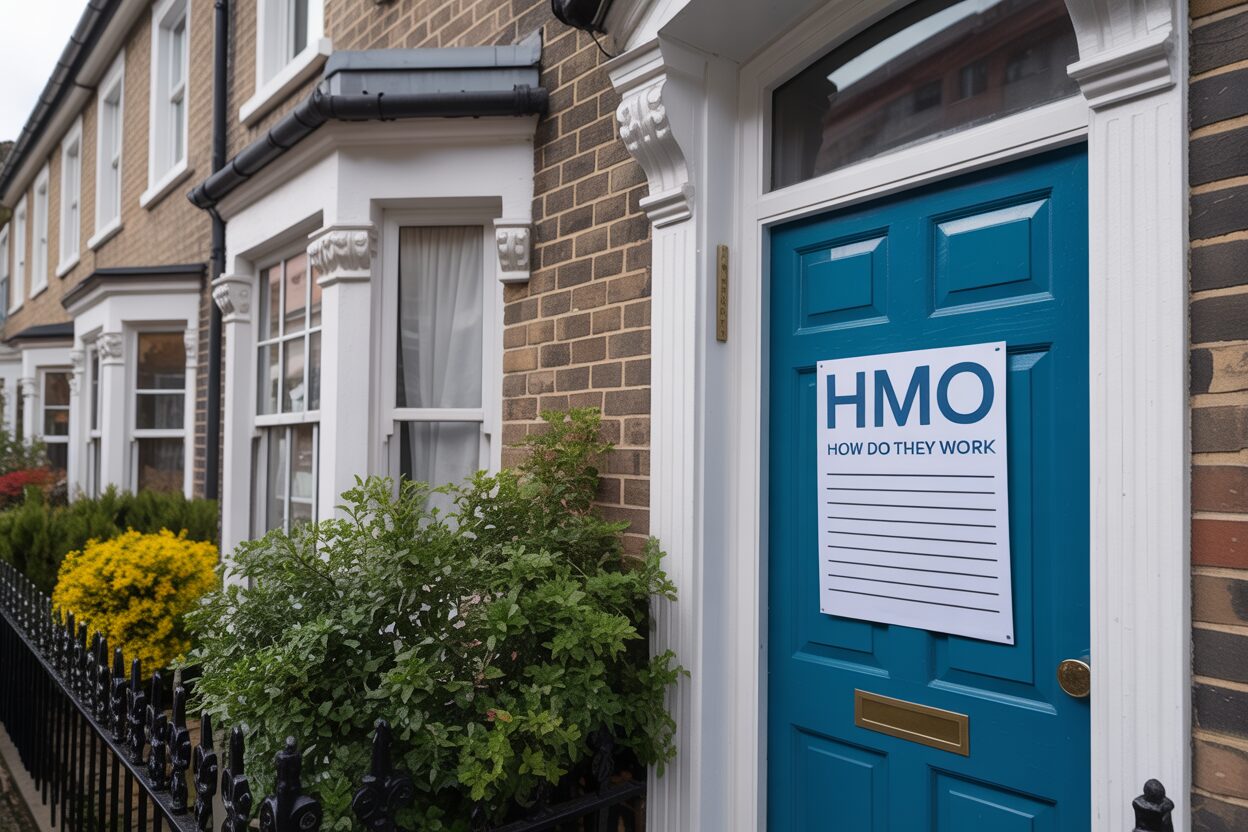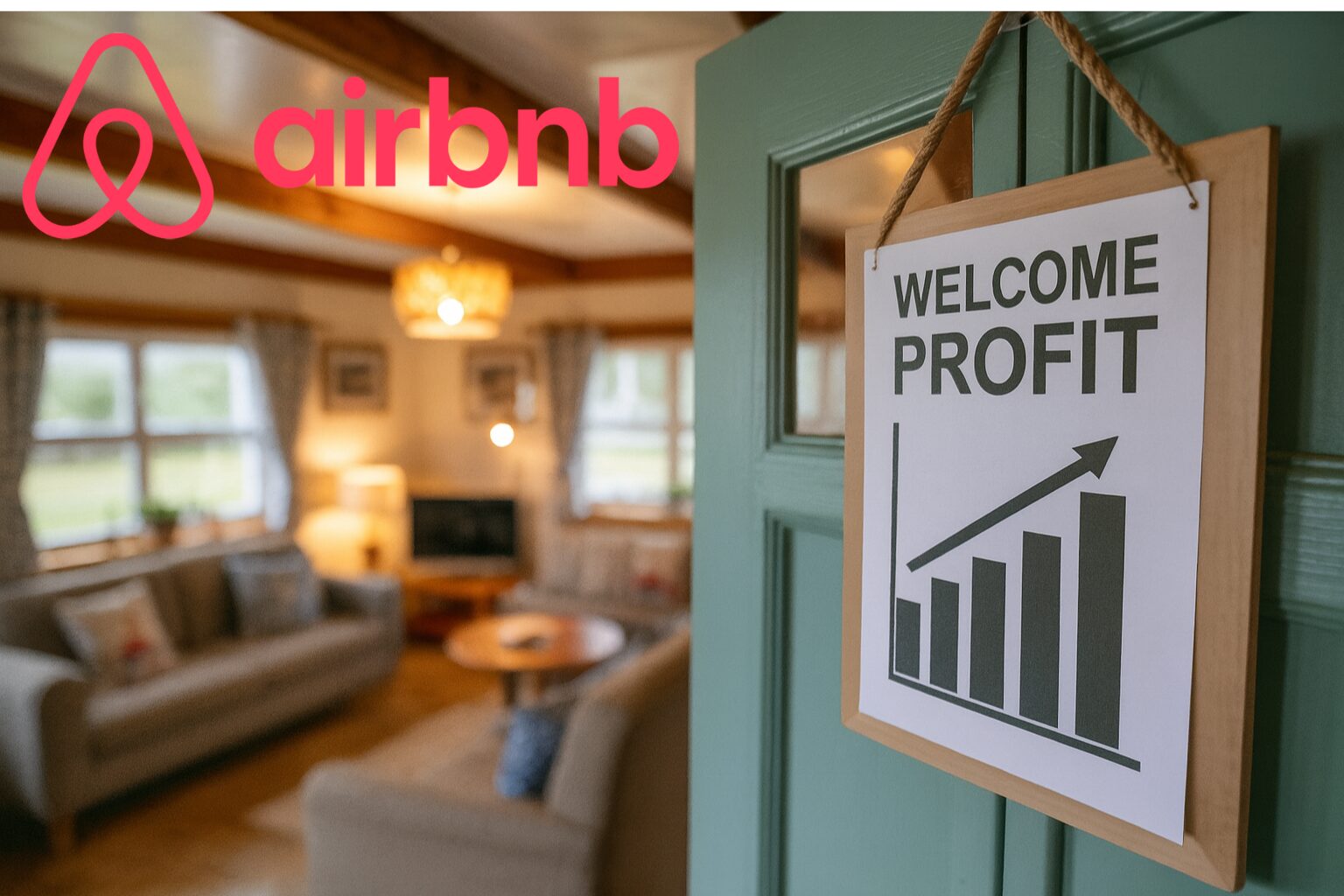
Buy-to-let landlords are worried about rising mortgage rates. They push up the rent you charge. This can lead to damaging voids that kill annual yields because tenants can’t afford your property anymore. HMOs are the perfect answer. They give tenants the rooms they want within budgets they can manage and landlords higher, steadier yields.
In this article, we share the exact HMO meaning with you and explain why investors love them. You’ll learn about planning, licensing and compliance and how to use our services to start your HMO portfolio.
What is an HMO: definition
A House in Multiple Occupation (HMO) is, according to the Housing Act 2004, a building or part of a building (including a flat) occupied by three or more people from more than one household. In the vast majority of cases, they share basic amenities like kitchens, bathrooms or toilets.
Standard HMOs are:
- Shared houses (standard test): A house or converted flat split into rooms/bedsits let to people from more than one household.
- Self-contained flats (sharing case): A single flat lived in by people from more than one household.
- Resident-landlords with lodgers: An owner-occupied home with three or more lodgers counts as an HMO. The owner-occupier doesn’t count as a household.
A “household” is a single person or members of the same family (including couples). Full-time students are treated as occupants during term time whereas short-term holiday lets don’t count as HMOs.
Some HMOs don’t require shared basic facilities. They include certain converted-building cases, section 257 blocks, and council-declared HMOs (section 255).
In this article, we focus on HMOs that legally require basic amenities. The reason for this is that these are the types of projects most developers and landlords invest in.
HMOs as investment vehicles
HMOs, like holiday lets and traditional buy-to-lets, are popular with investors and developers. HMOs offer higher yields because of their structure. Instead of renting a property to a single household, you rent it to multiple households at once. The positives are that this leads to higher rental payments and fewer void periods. The negatives are that there’s more work for you and higher expenses.
The key differences are:
- You rent a buy-to-let property to a single household on one contract. This generates one monthly payment. When they leave, the property is empty. You lose money because there’s no income to cover the mortgage.
- You let your HMO property to multiple tenants, each with their own contract so the amount of rent you receive is a lot higher. For example, you could let a four-bed house to a family for £1,250 a month. But, you could rent out each of the four rooms in a HMO for £450 a month. Instead of receiving £1,250 a month, you get £1,800. They’re better for voids, too. If you have a four-bed HMO and one tenant leaves, you still get rent from the remaining three tenants
It’s not quite as straightforward as this though. That’s because HMO management costs are higher for these reasons:
- In buy-to-lets, your tenant pays council tax and utilities bills. In most shared HMO houses, you pay council tax for the whole property (there are exceptions, like a single joint tenancy).
- To compete for tenants, most HMO landlords decide to bundle gas and electricity in with monthly rental fees.
- Managing multiple tenancies is far more challenging. Instead of dealing with one household, you’re handling several at once. That means more tenant queries, more contracts to manage and more maintenance. Compliance is also much stricter.
You can hand over the management to a third party but that adds costs. So, HMOs come with much higher yields but they also come with extra cost and effort.
HMO planning permission, licensing and compliance: what investors need to know
There are extra hurdles investing in HMO properties. They are:
- Where needed, you need planning consent to change the class of a property to an HMO.
- Then, where applicable, you need an HMO licence before you can let the property out.
- You are subject to regular inspection by the council.
Read on for more information on each step:
Stage one: securing planning permission
In England, you don’t always need planning permission. You can convert a Use Class C3 property (like a family home or flat) into a Use Class C4 property (three to six people) without approval. This is a permitted development under GPDO 2015 Part 3 Class L.
For HMOs with three to six occupants, you only need HMO planning permission if one or more of the following applies:
- Article 4: The council has removed permitted development rights in that area. You must apply for planning permission for a C3 to C4 change of use.
- Existing use class: Permitted development only covers C3 to C4 conversions. If your property isn’t C3 now (like a C2 care home), you must apply for permission.
- Existing conditions: A past planning condition or legal agreement on the property removes PD rights, so you must apply.
- External works: You’re also planning changes to the exterior, like an external escape stair. While the change of use may be a permitted development, the external works still need planning permission.
You always need planning permission for HMO conversions when your HMO will have seven or more tenants. These are called sui generis properties.
Even if you’re certain you don’t need planning permission, check with your council.
Stage two: understanding HMO licensing
There are three types of schemes your HMO property may need licensing under. They are mandatory HMO licensing, additional HMO licensing and selective licensing. The first two apply to HMOs only while selective licensing applies to all private rented property.
Here’s how they break down:
- Mandatory: This is compulsory for all HMOs with five or more tenants forming more than one household (‘large HMOs’). There is one exception. This is for self-contained flats in a purpose-built block containing three or more self-contained flats.
- Additional: You need an HMO licence in some council areas for smaller HMOs with fewer than five tenants to apply for a licence. Examples include Barnet, Havering, Merton and York. In some areas, the scheme only applies to certain types of property like Section 257 buildings. These are buildings that a landlord or developer has converted into self-contained flats. This is true in Portsmouth but only if you rent out fewer than a third of the flats and the building doesn’t comply with the 1991 Building Regulations.
- Selective: All landlords must seek a licence, whether they have a standard buy-to-let or HMO. For areas that require both a selective and additional licence, you may have to apply and pay for both licences.
The penalties for operating an unlicensed HMO includes heavy fines and Rent Repayment Orders (RRO). Under an RRO, tenants can claim back up to 12 months’ rent from you. You also lose the right to evict tenants under Section 21 (although certain exemptions may apply).
Stage three: HMO design and compliance standards
If you had to apply for either planning permission and/or an HMO licence, you could only have been approved by meeting the HMO compliance standards set by national law and your local authority.
After your property is ready to take in tenants, you’ll be subject to regular HMO inspections. Even if you don’t need a licence, the council can visit you using powers they have under the Housing Act 2004.
Requirements vary between councils and tests but expect to have to pass the following:
- Room sizes: There are national minimum room sizes in HMOs. Be aware that some councils may enforce room sizes larger than the legal minimum.
- Amenities: The people in your HMO will share toilet, bathroom and kitchen facilities. You need to make sure there are enough of each for the maximum headcount the HMO can accommodate.
- Communal space: Many councils require adequate communal space in HMOs. So, you need to provide a lounge or dining area for tenants to relax and socialise outside of their bedrooms.
- Fire safety: You must provide mains-powered smoke alarms to BS5839-6 (category and grade to fit your HMO’s characteristics) and fit emergency lighting where required by risk assessment or your council. There also needs to be a clear and unobstructed escape route with FD30S fire doors featuring self-closers. Inspectors make sure you closely follow all rigorous fire safety regulations.
- Energy efficiency: The property must meet all current EPC requirements for HMOs.
Where an HMO licence is needed, there is also a “fit and proper person”: The council is likely to refuse an application for serious past criminal convictions. This includes fraud, dishonesty and breaches of landlord law or housing law.
Which type of HMO should I invest in?
Certain HMO styles deliver the most impressive returns of investment. Like with other property investments, the key is choosing your target market first. Then, choose a location and type of finish that would make your HMO appealing to them.
The following types of HMO are popular:
- Student HMOs: In September, students sign up for 12-month tenancy. Every year, the same pattern repeats. Student HMOs attract lower rents but generate revenue nearly all of the time. Find somewhere near to unis or colleges and provide a durable, practical place to live.
- The HMO co-living model: Many young professionals recently left uni. They got used to living and socialising with their peers. Ideally, they’d like that to continue so they choose the HMO co-living model. Provide them with higher-end finishes and en-suite bathrooms to justify higher rents. Just as important, give them a great shared space where they can cook, eat and relax together.
- Social housing: Partner with local authorities, housing associations and charities. Provide accommodation for specific demographics like key workers or care leavers. These agreements offer long-term, guaranteed rental periods.
- Commercial to residential: A more complex but potentially high-reward strategy. This involves converting commercial properties like offices ,pubs ,or retail units into large, high-capacity HMOs. Create modern, purpose-built shared living spaces, often very close to transport hubs and city centres.
What are the pros and cons of investing in HMOs?
The top three advantages and disadvantages for investing in HMOs are:
HMO advantages
- Higher cash flow: Room-by-room renting brings in more cash than whole property renting. You make more money and can build up the deposit for your next investment faster.
- Reduced void periods: Lose one room in a four-room house and you collect 25% less rent. If a family moves out of a traditional buy-to-let, there’s zero income until you find a replacement.
- Strong demand: Single property rental prices are rising fast. That means the market is pricing out people who want their own place. Affordable, shared accommodation is in short supply. This creates high demand among demographics like young professionals and students.
HMO disadvantages
- Complex regulations: Planning, licensing and management rules are complex and plentiful. Understanding these many different HMO rules is key to avoiding significant penalties.
- More management: You might be dealing with seven or more people with tenancy agreements, not just one person. This ups your day-to-day workload, from handling enquiries to coordinating maintenance. You can outsource this to an HMO manager but it will eat into your profits.
- Higher setup costs: Converting a property to an HMO is expensive. Light refurbs will eat into your budget. Heavy refurbs can run into six figures and months of work before you collect your first rent. Although lenders will help you, you’ve got to have a lot of your own money upfront in the first place.
HMO Architects: profit from the boom in HMO demand
For both landlords and tenants, houses in multiple occupation make sense. Landlords enjoy greater yields and gain protection from total property voids. Tenants get attractive, well-located accommodation at lower prices.
HMO Architects’ clients view this type of property as a great investment strategy. Yields on traditional buy-to-lets are OK and holiday cottages slightly better. Right now though, HMOs offer the greatest potential. [Related article: Planning permission for Airbnb and holiday lets in the UK]
We’ve helped over 750 clients build HMO property portfolios. We’ve navigated the complex rules of 200 different councils and won planning permission for client projects. Our success rate is 97% with a total project value in excess of £100m.
- Soham Road, London (5 units): We obtained planning permission for a budget-led C3 to C4 conversion in an Article 4 area for our client. The work involved relocating the stair and adding a small extension to create extra compliant rooms and a real communal space. The value of the property rose from £450,000 to £750,000 and rent nearly tripled from £1,600pcm to £4,500.
- South Bank Road, Liverpool (6 units): We took a neglected terrace back to brick mid-terraced property, added rear and dormer extensions and achieved two en-suites plus two shared bathrooms to meet HMO amenity ratios. The scheme lifted the property value from £85,000 to £280,000 and rent to £2,800 pcm, more than five times the previous level.
- Gunhild Close, Cambridge (6 units): We re-planned a family house into a six-bed HMO with all en-suites and tea points, adding a dormer for head-height and upgrading the thermal performance for a better EPC rating. The value of the property climbed from £85,000 to £260,000 and rent from £350pcm to £2,500.
If you think HMOs are right for you, here’s where we can help:
- Investment strategy calls: Book a live call with Ryan Windsor, our property investment specialist. Ryan has worked on over 2,200 projects for clients and started building his own extensive property portfolio when he was 17. Tell him the property and idea you have in mind and he’ll assess its viability.
- Feasibility study: Is your idea architecturally feasible? Speak to Giovanni Patania, our lead architect. Get pre-buy and design studies from him and his team. We can provide a full feasibility report for your project, too.
- End-to-end service: Access a range of key services under one roof. We provide architecture design and planning to building regs and interior design. The experts you need are all in one place.
- Wider network: Plug into our pool of trusted professionals. Access experts ranging from specialist builders to property finance brokers when you need them.
Check out our detailed HMO legal FAQ and find out more about the true cost of unlicensed HMOs on our website.
View our range of development finance case studies to see how we’ve helped clients turn their ideas into sound investments. Read customer stories on HMO, flat, holiday let and housing projects.
Call us on 01223 776 997 or email us direct.
HMO FAQs
What does “only or main residence” mean for an HMO?
An HMO is defined by where tenants live as their only or main residence. If at least one person treats the premises as their permanent home, it counts. Councils usually consider an HMO as students and seasonal workers’ main residence when present. Short-term holiday lets don’t qualify.
What are the HMO management regulations?
HMO management regulations set the extra legal responsibilities for landlords. You must keep the property in safe repair, supply adequate cooking facilities and meet certain standards for communal areas. These duties are set out in the Management of Houses in Multiple Occupation (England) Regulations 2006. Other relevant rules include Building Regulations and local HMO standards. Breaches can lead to fines or Rent Repayment Orders.
How much is the HMO licence fee?
The licence fee varies by council. Most HMOs pay between £500 and £1,500 per property depending on size and type. Larger shared houses or converted blocks may attract higher fees.
What happens if I run an unlicensed HMO?
Operating an unlicensed HMO is a serious offence when the property should be licenced. You risk unlimited fines, Rent Repayment Orders, and the loss of Section 21 eviction rights. Councils take action if they find three or more people from two or more households living together without a valid licence.
Do HMOs always house separate families?
Not always. An HMO can be home to one family plus unrelated tenants, or several separate families. What matters is that two or more households live together and share facilities.
What counts as a household in an HMO?
A household is defined as one family, a couple, or a single person. Couples in any legally recognised form count as one household.
What is the most common type of HMO?
The most common type is a shared house with four to six unrelated tenants. In most HMOs, people live under separate contracts but share kitchens and bathrooms.
How do HMOs work in converted blocks?
Some HMOs are in converted blocks of flats. If less than two thirds of the block is owner occupied and the building was not originally constructed as flats, it may fall under Section 257 rules and need a licence. Section 257 applies where the conversion did not comply with Building Regulations at the time and fewer than two-thirds of flats are owner-occupied.
What standards must HMOs meet?
HMOs must meet certain standards for space, fire safety, cooking facilities and energy efficiency. These are set by national legislation and often strengthened by local councils. For shared facilities, see the 2007 Additional Provisions Regulations (Schedule 3).
Giovanni is a highly accomplished architect hailing from Siena, Italy. With an impressive career spanning multiple countries, he has gained extensive experience as a Lead Architect at Foster + Partners, where he worked on a number of iconic Apple stores, including the prestigious Champs-Élysées flagship Apple store in Paris. As the co-founder and principal architect of WindsorPatania Architects, Giovanni has leveraged his extensive experience to spearhead a range of innovative projects.




